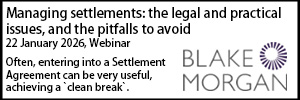The strategic importance of maintaining a positive workplace culture
- Details
Gareth Edwards recently reported on the upcoming new mandatory duty to take reasonable steps to prevent sexual harassment in the workplace, which is due to come into force on 26 October 2024. In this follow-up piece, he discusses how the new sexual harassment law highlights the strategic value of maintaining a positive workplace culture.
Various aspects of the employment law framework require employers to manage workplace culture to minimise legal risks. A positive workplace culture can reduce the likelihood of claims, including whistleblowing, discrimination, harassment, personal injury negligence, breach of contract, and unfair dismissal, including constructive dismissal.
Strategic benefits of a positive workplace culture
It is strategically important for organisations to maintain a positive workplace culture. At its most basic level, a positive culture enhances staff happiness and job satisfaction, leading to a more motivated workforce that is likely to work harder and stay longer with the organisation. Research shows that "positive work cultures, characterised by supportive leadership, open communication, teamwork, and trust, have a significant positive impact on employee well-being, job satisfaction, motivation and productivity".
It is possible to identify specific commercial benefits which are likely to be impacted by workplace culture, including:
- Increased staff productivity and better performance
- Improved employee wellbeing, resulting in lower absenteeism and reduced costs associated with sick pay and temporary cover
- Enhanced employee retention and reduced turnover costs including the costs associated with hiring and training new staff
- Reduced risk of successful Employment Tribunal claims, and the resulting potential for financial and reputational damage to the organisation
Utilising leaders to drive a positive culture
At its core, workplace culture encompasses an organisation's mission, vision and values which influence its daily operations and decision-making processes. A workplace's culture will manifest in the way employees collaborate, communicate and handle conflict, as well as in its workplace environment.
Leaders play a crucial role in shaping and maintaining workplace culture. As a minimum, senior leaders should embody the core values and behaviours the organisation wishes to see in its workforce. As role models, leaders set the tone for the organisation. Their behaviour influences employees, and displays of positive, respectful and professional conduct will help create the right environment for the entire organisation.
An effective leader goes beyond simply embodying core values; they lead by example in implementing key policies and procedures that shape workplace culture. This means modelling inclusive behaviour, supporting staff in raising concerns, encouraging open communication and adopting a zero-tolerance attitude on issues such as discrimination and harassment.
Leaders should also recognise the impact of diversity and inclusion on workplace culture. Evidence shows that prioritising these values benefits various groups including women, those from ethnic minorities, LGBTQ+ individuals, and people with disabilities. Where non-dominant groups are supported to succeed at work, the organisation will maintain a more diverse workforce, and a more inclusive culture.
Psychological safety and workplace culture
Workplace psychological safety refers to an environment where employees feel secure in expressing their ideas, concerns, and mistakes without fear of negative repercussions. When psychological safety is high, employees will be more likely to contribute fully, take risks, and collaborate effectively, driving the organisation's overall success.
Psychological safety forms a foundation for a positive workplace culture, fostering open communication, trust, and respect. This environment allows employees to freely share ideas and concerns. In contrast, a toxic culture undermines psychological safety. This can lead to fear, reduced engagement, and lower performance.
Employers are not only legally obligated to ensure a physically safe workplace through risk assessments but also responsible for protecting employees' psychological safety. Employers are increasingly facing risks in relation to the protection of employee psychological safety at work. Poor practices on psychological safety might lead to Employment Tribunal claims and reputational damage.
In recent years, key industry regulators including the Solicitors Regulation Authority, the General Medical Council and the Financial Conduct Authority have highlighted the importance of psychological safety in workplace culture. Each of these regulators has taken steps to explain how workplace culture factors into staff health and wellbeing. At a basic level, an unhealthy workplace culture can impact not only those within the organisation but also clients, service users and other third parties that interact with it. In an employment context, the recently published independent culture review of the Nursing and Midwifery Council highlights the impact of a toxic workplace culture on staff at all levels.
The strategic value of an effective listening exercise and risk assessment
Organisations reflecting on our previous article might be planning to carry out a staff listening exercise and risk assessment in advance of the new law on workplace sexual harassment coming into effect. A sensible first step would be to widen that exercise, to capture not only specific risks relating to workplace sexual harassment but also any wider risks that could impact on staff psychological safety at work.
Risks in any individual workplace may vary, and the purpose of the listening exercise should be to pinpoint areas where the organisation can make meaningful improvements. When designing a listening exercise, avoid asking questions that focus solely on legally defined protected characteristics such as sex, sexual orientation, race and disability. It may be helpful instead to consider the impact of more nuanced issues that could be affecting staff psychological safety at work, including:
- Organisational factors, such as staff perception of benefits and career progression opportunities, staff perception of the organisation's approach to flexible working, whether adequate training and mentorship opportunities exist, staff perception of the quality of leadership
- Issues that create legal risk, such as any instances of discrimination or harassment, and how these were resolved, difficult workplace relationships and how these are managed, and the organisation's approach to banter
- Personal factors, such as neurodiversity, mental health, menopause or caring responsibilities outside work, and what support is available to help staff manage these issues and still succeed at work.
Once the staff listening exercise is complete, its results can be used to inform your organisation's individual risk assessment. Continue to review the identified risks to ensure the risk assessment remains current and captures any new and emerging risks to workplace psychological safety.
Other key strategies to promote workplace psychological safety
In addition to carrying out a staff listening exercise and a workplace risk assessment, there are wider strategies organisations could use to help protect workplace psychological safety and create a culture where staff feel safe and supported at work:
- Model inclusive behaviour: Leaders should lead by example in demonstrating respectful and inclusive behaviour to promote a culture where staff feel comfortable raising concerns
- Encourage open dialogue: Staff should be invited to regular check-ins so that can share concerns and feedback. Provide options for anonymous feedback to ensure employees can voice issues without fear of retribution Foster a supportive environment - staff should be recognised and rewarded for their contributions and efforts. Where appropriate, peer mentoring and support networks can also help build trust and encouragement among staff
- Promote work-life balance: To the extent that it is possible to do so, the organisation may wish to promote flexible working and remote working opportunities to help staff balance their personal and professional lives
- Provide training and development: Appropriate training should be delivered to all staff, including on workplace equality and diversity. This can include eLearning and in-person training. Train line managers on creating psychological safety, handling difficult conversations, addressing concerns, and conducting effective investigations
- Implement fair policies: Policies and procedures should be kept up-to-date and in line with current law and best practice. They should include clear processes for raising and addressing workplace issues where they arise. Apply policies consistently and maintain a zero-tolerance stance on discrimination, harassment, and bullying.
- Create a culture of learning and reflection: Organisations should encourage continuous learning and development, and a mindset where mistakes are supported and colleagues work together constructively to resolve them and learn from them.
It is important to recognise that the recommendations in this article are not one-off actions but ongoing tasks that organisations should regularly revisit. By keeping workplace culture under review, an organisation is more likely to be able to evidence proactivity, measure progress over time, and demonstrate if required that it took necessary action to protect staff.
Gareth Edwards is a partner at VWV.











